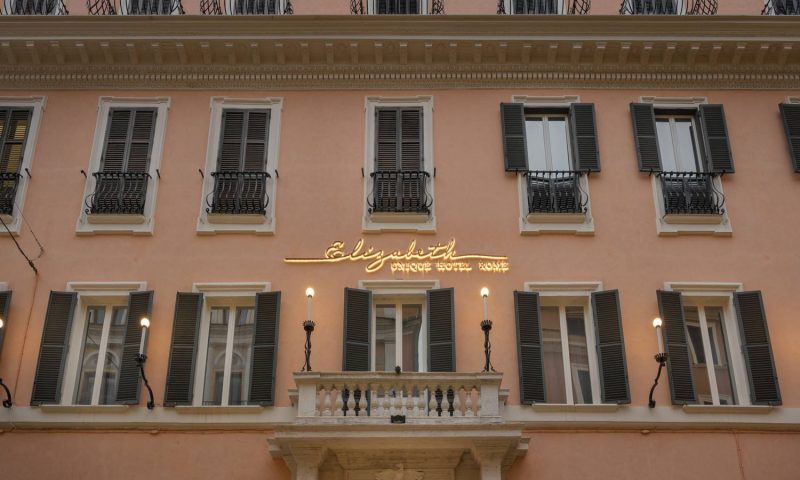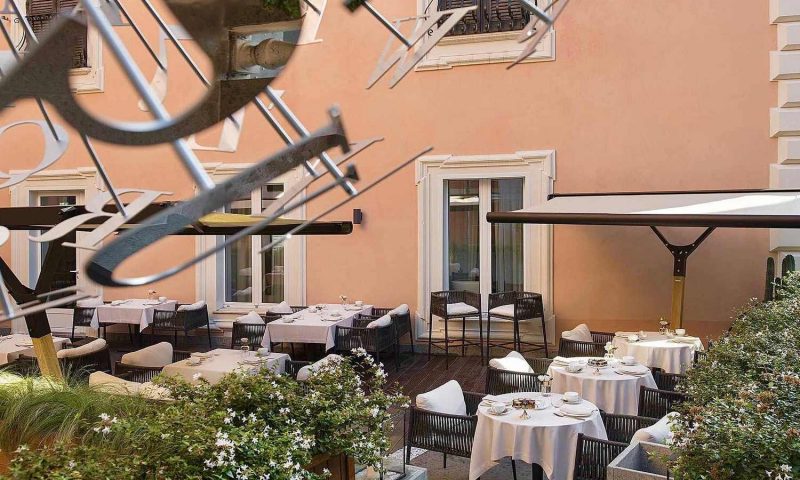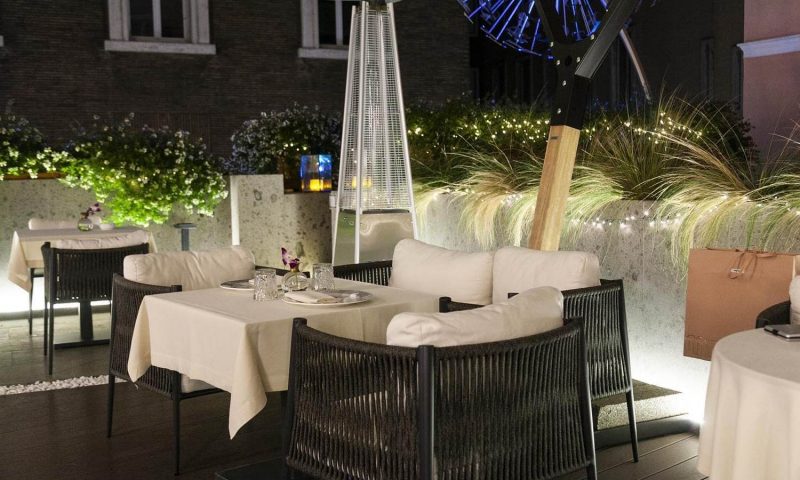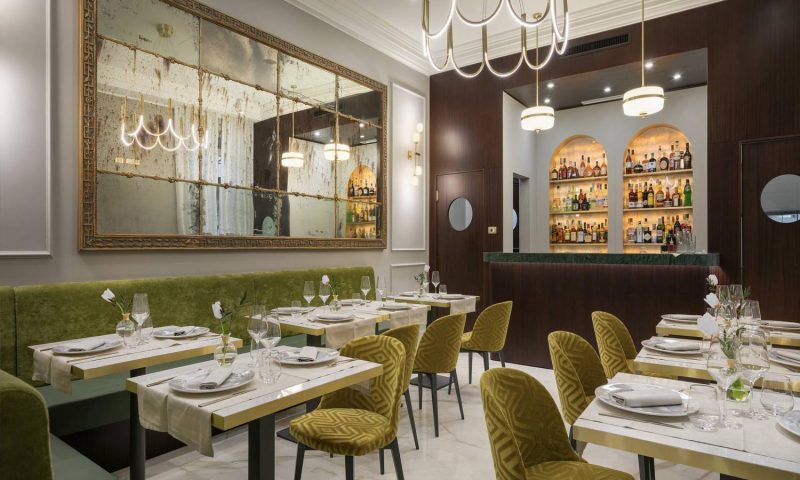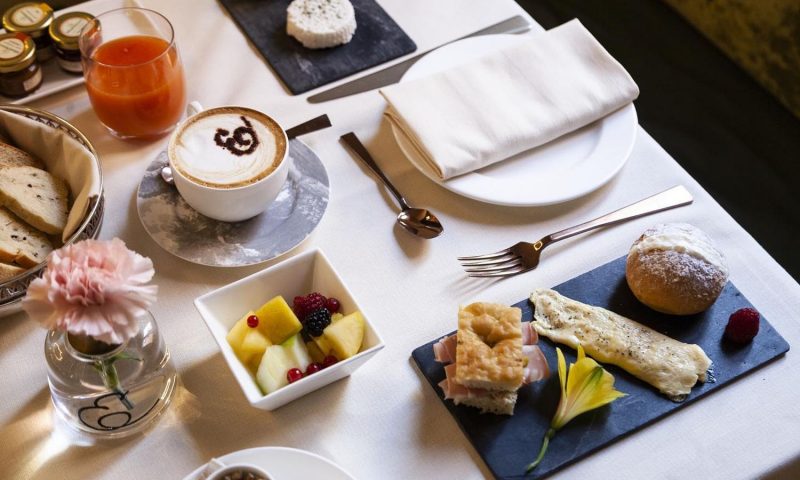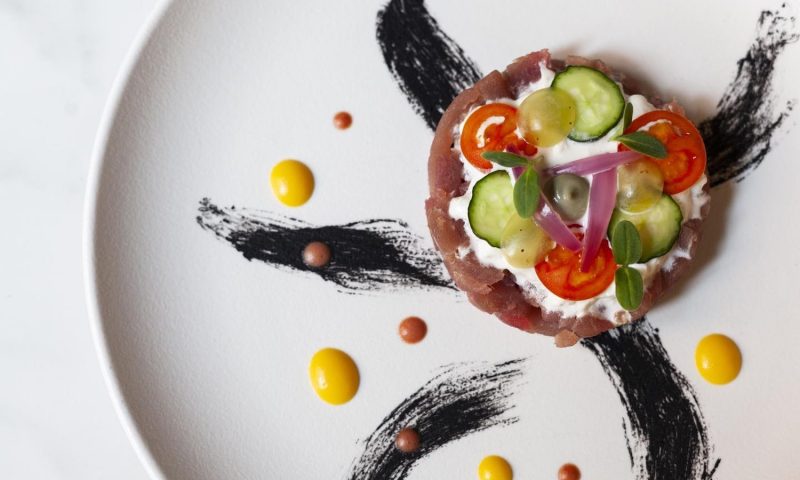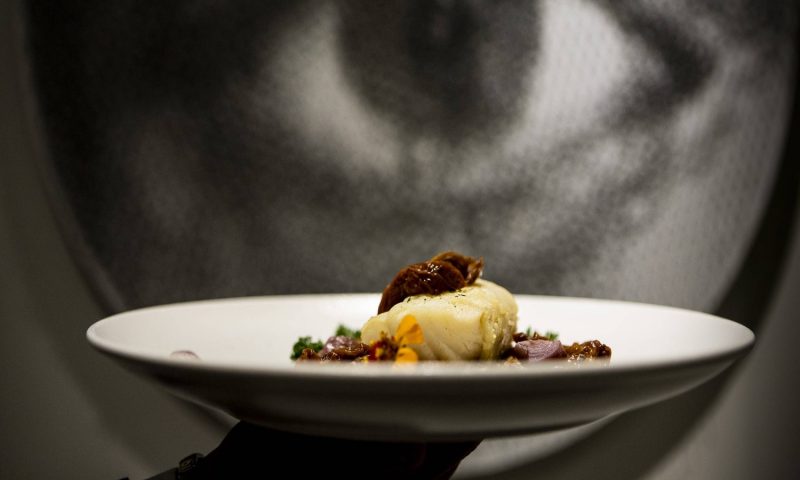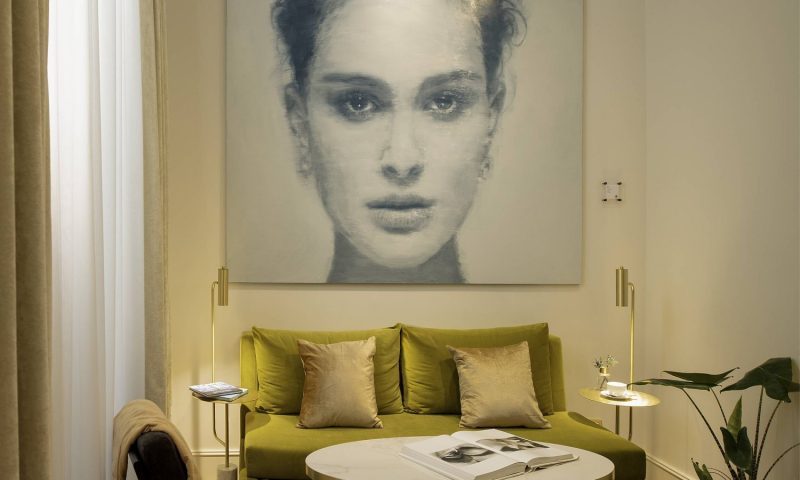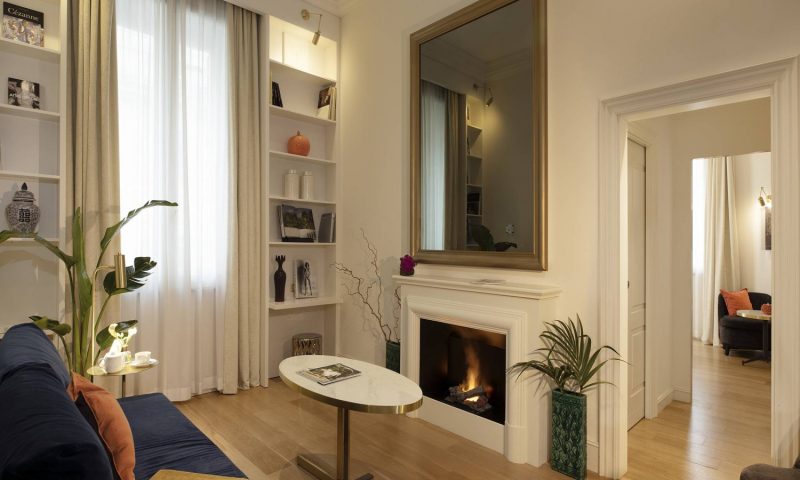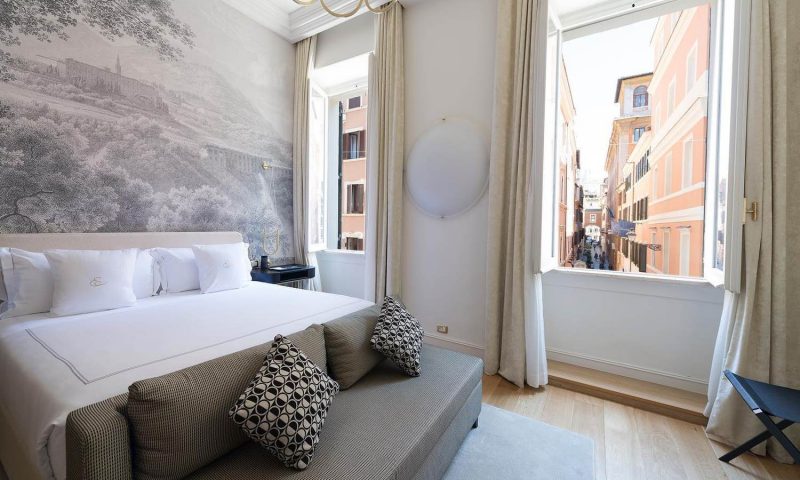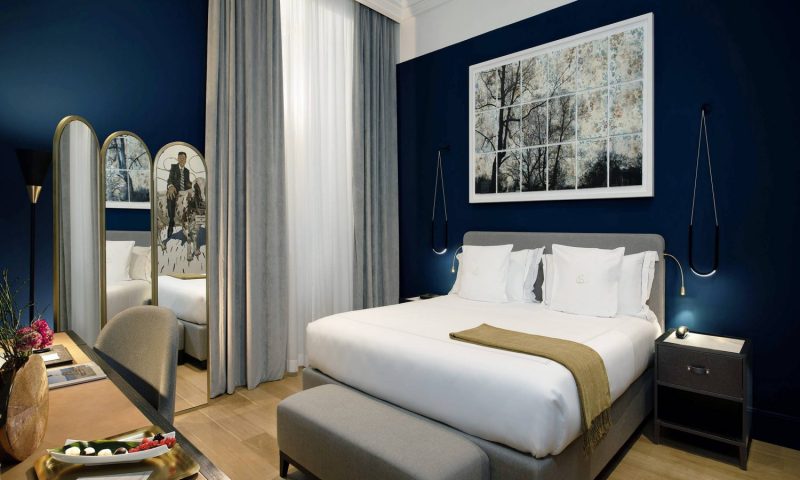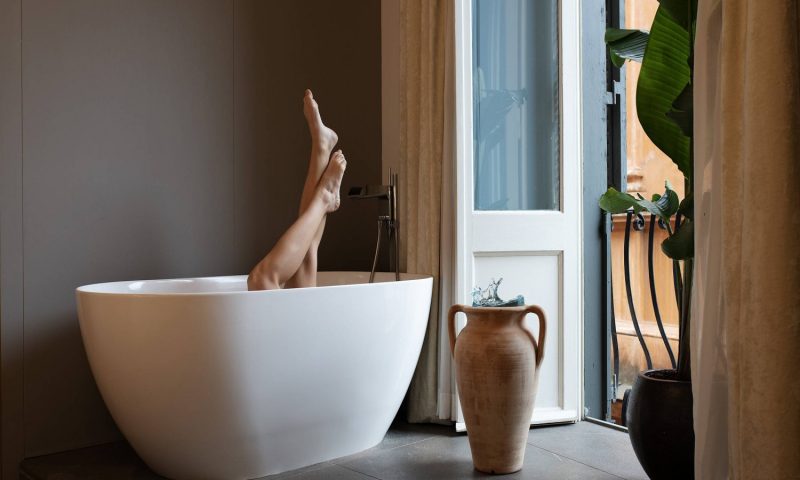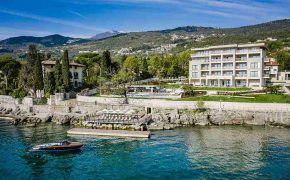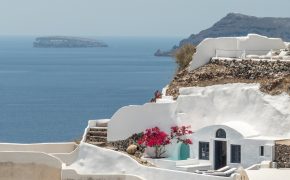Elizabeth Unique Hotel Rome is a precious residence where ancient stories interlace with modern ones, hospitality is a generous and genuine embrace, and wishes are fulfilled before being expressed.
The hotel’s cosmopolitan and never conventional atmosphere seems to evoke memories of the first modern explorers, scions of European aristocrats, who during their ‘grand tours’ came down to Rome and were especially charmed by centuries of history, art and culture.
With the same intensity and refinement, in Palazzo Pulieri Ginetti, just a few minutes from the Spanish Steps and Piazza del Popolo, right in the heart of the city, travel is celebrated as an unprecedented versatile experience, unique by vocation.
MANIFESTO
Luxury is not about appearances, on the contrary, it is about being understood, finding satisfaction in the small details and gathering inspiration through artistic expression. The journey crafted at Elizabeth Unique Hotel touches both the ancient and the contemporary with the additional privilege of becoming part of a community of illuminated travelers.
Besides the artistic and cultural cross-pollination, Elizabeth Unique Hotel offers all services peculiar to big five-star hotels, with unprecedented criteria of personalization.
We believe that today more than ever, a sophisticated guest wishes and expects to experience unique, genuine, extraordinary, priceless moments: this is the real criterion to define luxury, and its trademark.
We undertake to offer an alternative to the existing globalized and standardized system and to value what is rarest, more authentic, more precious and moving, in order to put it at our guests’ disposal.
We address ourself to individuals, not to targeted customers, who associate the word ‘luxury’ to self-referential operators, who abuse it and cannot ‘walk it like they talk it’ anymore. We stick to our philosophy in every field, with care and consistency.
We respect and care for our personnel and keep looking for new ways to involve and motivate them, in order to develop an incomparable sense of belonging. Actual quality, not just the sense of it. Every detail, relating both to aesthetic and to service, has been conceived and realized without compromise.
Our ultimate technological systems guarantee the maximum comfort, safety and prevention. The hotel operates in compliance with regulations and is in possession of all titles, permissions and authorizations required by competent public bodies.
We believe that brilliant intuitions and artistic masterpieces are an extraordinary cultural reservoir one can draw from. Creativity and the courage to dare and to experiment, starting from sound historical-cultural bases, are the catalysts that urge us to explore new kinds of hospitality.
From the concept of spaces to the furniture, from the atmosphere to the reception of our guests. Such impulses inspire our artisans, who apply them to the matter. We shun industrial production, which would spoil the balance between innovation and authenticity.
Also in the field of in-house catering, we choose no compromises, even though this entails complex logistics: we buy locally sourced products and prefer homemade foods, such as the bread and confectionery prepared in our kitchens.
Raw materials eaten close to their growing site are an incentive to respect origins and traditions. A simple and genuine approach that resumes our ancestors’ ancient habits. We carefully select a group of local producers who can guarantee healthy food and unique tastes, so as to depart from large-scale retail trade.
We fight against decay and decline, deploying ethical, aesthetical and environment-friendly values. We believe that making a profit is not the cause, but the effect of pursuing quality. We wish to honour our artistic and cultural heritage through heterogeneous collaborations with exponents of the city’s culture who come from different intellectual paths.
ROOMS & SUITES
In a time when everything runs fast and stays on the surface, taking a moment has a deeper meaning. Elizabeth Unique Hotel’s rooms are an invitation to find the appropriate time.
Thirty-three rooms – Initiale, Deluxe, Junior Suite and Suite – where beauty manifests itself in a balanced whole of magnificent details, colours reveal themselves in perfect tones and every corner welcomes the natural elegance of the city’s illustrious noble palaces.
All rooms at the Elizabeth Unique Hotel are different from each other and are designed to offer absolute excellence in terms of elegance, service and technology.
Studio Marincola Architects designed the interiors by reinterpreting two distinctive elements in a modern key: the tradition of the arch in Roman architecture and the art of etchings of the late 19th century of the “Italian Grand Tours”.
The same Studio also designed the lighting project, created exclusively for the hotel. Every detail is taken care of with the utmost attention, starting from the quality of sleep, made special thanks to the patented ad hoc mattress by the company Dorelan and the ability to customize pillows in accordance to personal sleeping habits and preferences.
The walls of many rooms are embellished with works of art curated by the Russo Art Gallery, commissioned and created to interpret the soul of the property.
Available to all guests is the complimentary mini bar, which includes a selection of Italian delicacies. There is also a tablet with an exclusive concierge service, with useful insights on the city and hotel information. The experience is finally enriched by Laura Tonatto’s signature amenities and fine cotton and silk linen.
ELIZABETH GRAND SUITE
The Elizabeth Grand Suite is composed by one Suite and one Junior Suite together with the cozy library overlooking Via del Corso. The original black and white wallpapers inspired by the epic ” Italian Grand Tours” are accompanied by an impeccable palette of natural tones and golden details.
An arched entrance leads into the bedroom with a king size bed and to the large living area with a comfortable double sofa bed. The arch motif is also represented in the scenic neon lighting fixture d.
The Suite and the Junior Suite enjoy a marvelous view on Via del Corso and the library has a small balcony overlooking the main street. Maximum capacity : 4 adults, 2 children up to 12 years old and 2 infants in cot
SUITE SPA
The original black and white wallpapers inspired by the epic ” Italian Grand Tours” are accompanied by an impeccable palette of natural tones and golden details.
An arched entrance leads into the bedroom with a king size bed and to the large living area with a comfortable double sofa bed. Some of the suites have whirlpool bathtubs, while the Spa Suites give guests the luxury of a private sauna. The majority of the suites overlook Via del Corso.
DELUXE JUNIOR SUITE
The original black and white wallpapers inspired by the epic “Italian Grand Tours” and, in some rooms, the fireplaces make the Deluxe Junior Suites particularly romantic. The tapestries choose shades of gray, blue and orange.
The arch becomes the design motif of the wood paneling, it articulates the space and identifies its functions becoming a walk-in closet and a mini-bar. The delight of the spectacle is the view of the renowned Via del Corso. The rooms are also equipped with a living corner with a single sofa bed.
DELUXE SPA
Prestigious four-poster beds in black oak are the protagonists of the Deluxe rooms. The ocher curtains play an important role in the game of contrasts that characterises the hotel’s interior an even more lively expression. In the Deluxe Spa there is a private sauna, which makes the experience at Elizabeth Unique Hotel even more exclusive.
ELIZABETH’S MANSION
The exclusivity that characterizes the Elizabeth Unique Hotel is embellished by the intimate and discreet atmosphere of the Mansion, a quiet home in the historic center of Rome, a few steps from the main entrance.
The architectural project reflects the choices that Studio Marincola has undertaken in the hotel, enriching the precious building with contemporary details and original furnishings.
The Mansion consists of six rooms, that can accommodate a maximum of sixteen guests, 12 adults and 4 children. You can also book the entire property, offering maximum privacy and discretion.
Elizabeth’s Mansion proposes six rooms and suites distributed throughout two floors of an old palazzo on Via delle Colonnette, just a few meters from the main building. The Mansion mirrors the philosophy and distinguished inter design signed by Marincola Studio.
MANSION SUITE
The ideal combination of cold and warm tones, the original design of furniture and lighting and the masterly attention to fine finishes, offer Mansion Suite guests an absolutely unique setting.
The room has a secluded lounge with a double sofa bed and two bathrooms with a double shower and a whirlpool bathtub. This room is located in a separate building with a private entrance located just 10 meters for the main entrance of the Elizabeth Unique Hotel.
DONNAE BISTROT
The DonnaE Bistrot invoke the versatile nature of places conceived to be shared. DonnaE Bistrot is inspired by the traditional feminine hospitality, typical of our beloved south Italy.
In the morning, you can linger over freshly baked brioches, muffins and tarts, spiced teas and perfectly balanced infusions, the clear reinvigorating flavours of seasonal fruit, and superb compositions of soft and velvety eggs, which delicately stimulate and amaze the senses. Elizabeth’s breakfast is an à la carte brunch that reveals the gracefulness and discretion of noble English breakfasts.
CREATIVE MENU
The hotel’s gourmet offer continues with a collection of ‘creative menus’ inspired by the traditions of Italian gastronomy and enriched with international suggestions.
We have worked to offer you the best gastronomic summery that we could imagine and we hope that tasting our dishes, you will feel the genuineness of the ingredients and the craftsmanship of the home-made, that you will remember flavors from your childhood and you will be amazed by our unexpected combinations.
Each dish is an unprecedented combination of flavors which come together in every dish. The Bar menu is a tribute to the most famous mixology and offers a collection of signature cocktails and a selection of only the finest Italian wines and bubbles exclusively selected by our Restaurant Manager.
The aperitivo is a generous creative introduction to the poetry of a Roman dinner. Drinks and glasses of wine are served with delicious sets of homemade finger food. Many ingredients come from the family estates, from the olive grove to the dairy farms that produces homemade mozzarella and thus guarantee excellent genuine local products.
ENRICO SERAFINO WINERY
Always attentive to the choice of quality and sustainable products, for our wine proposal we offer a refined selection of an Italian wine producer such as Enrico Serafino.
Founded in 1878 in Canale d’Alba, Enrico Serafino has been one of the first Piemontese Historical Wineries to create prestigious Traditional Classic Method cuvées such as Asti Champagne and Regina Brut Champagne in its 19th century underground cellars.
In the early 20th century the Traditional Classic Method of Enrico Serafino, well-known for the refined art-déco logo, together with other Piemontese sparkling wines, conquered the world.
The elegant advertising posters appeared in the streets of New York, London and Paris and the bottles became the main characters of the happy and successful moments of Hollywood movies with their presence in the most elegant parties.
Today almost nothing has changed from the vineyard to the winery, including the rules and the gestures of those who work there. Expert, precise—almost ritual—acts, because quality cannot be improvised.
The vineyard is the Alta Langa area, within the most harsh Piemonte hills, with marly and calcareous-clay soils. The background of famous novels written by Pavese and Fenoglio, the vineyards that have given fame to the great Piemontese red wines. Here Pinot Noir grapes excel, which have always been the favorite grape of the winery, as well as those of Chardonnay.
WELLNESS
In a world where we are always rushing and time assumes a priceless value, Elizabeth Unique Hotel offers a way out of the daily routine, a sensorial experience capable of restoring body and soul.
Being it one of our Spa Suites, where private sauna and whirlpool bathtub welcome our guests in a cozy and relaxing atmosphere, or a magical treatment within the room’s walls, enjoy your wellness wonderland.
In the heart of Rome, Elizabeth Unique Hotel partners with one of the most popular wellness centers to pamper clients and help them purify themselves from toxins and reactivate their own energies. Asian massage techniques, therapies that become “Unique” experiences to reach the inner peace.
Discover our offer, contact our Concierge and book your exclusive treatment either in your room or in this incredible wellness center located only few steps away.
ART
Artistic works enrich Elizabeth Unique Hotel’s public spaces and rooms. Their curator is Fabrizio Russo, owner of the historical Russo Art Gallery on via Alibert, a few steps away from Piazza di Spagna.
The protagonists of the collection are Italian artists, such as Enrico Benetta, who ‘writes’ sculptures where letters have a new narrative approach; Veronica Montanino and her labyrinthine hypnotic painting; and Manuel Felisi with his macro collages about a Nordic imagery of skies and forests.
Michael Gambino’s evanescent graceful works, which seem to sculpt the harmonic flow of the organic matter, adorn the walls. Luca Di Luzio exhibits works from the project Atlas Ego Imago Mundi, where he portrays parts of his body as imaginary islands on an atlas.
Finally, Giorgio Tentolini makes sculpture-paintings weaving metal wire creating faces, statues, details, which through the research of light are prepared for a new existence.
LOCATION
Every morning the Elizabeth Unique Hotel Rome’s guests wake up in the softened atmosphere and the superb elegance of one of the city’s most iconic contexts. The first tourists walk on streets still empty, regulars meet at the bar, and shopkeepers raise the shutters of historical shops.
The neighbourhood slowly reveals the versatile liveliness of Via del Corso, the secluded and exclusive atmosphere of Via della Frezza, the old-time poetry of Via delle Colonnette, famous for sculptor Canova’s studio, and the bucolic soul of the Pincian Hill and the Villa Borghese, precious urban oases and ideal destinations for running.
A few steps away, Chiesa di San Giacomo, Chiesa Gesù e Maria, and Basilica dei Santi Ambrogio e Carlo amaze with their delightful baroque surprises. Chiesa di Santa Maria del Popolo, in the homonymous square, guards two great masterpieces by Caravaggio: The Conversion of St. Paul and The Crucifixion of St. Peter.
Palazzo Pulieri stands in an idyllic and strategical corner that allows a close interaction with the artistic legacy of the Tridente. It is the perfect starting and ending point of a day spent discovering and celebrating Rome’s universal beauty.
NEIGHBOURHOODS
Discovering the city of Rome means embarking on a journey in search of beauty in its highest and purest form, starting from the incomparable archaeological ruins to the illustrious exhibitions of contemporary art.
MONTI
Its older name was ‘li monti’ (the hills), since it lies among the Esquiline, Viminal and Quirinal hills. Monti is one of the most charming and picturesque Roman neighbourhoods. Its narrow streets, old mansions, extant artisans’ shops and atmosphere take you back to a forgotten Rome.
Walking along Via Madonna dei Monti, you will catch Bohemian glimpses, nostalgic about an old-time Rome. Where Via Baccina crosses Salita del Grillo, a magnificent wall retains a collection of delightful ex-votos, and Palazzo del Grillo unveils a spectacular view of the Roman fora.
Via Panisperna crosses the neighbourhood, and its first stretch goes down from Largo Magnanapoli to Largo Angelicum. On top of a double flight of steps, you can admire the baroque Santi Domenico e Sisto church, whose façade tinges with shades of pink at sunset. Inside, spectacular Bernini works, like the high altar, await you.
On the left, you can enjoy the view of Villa Aldobrandini and its sixteenth-century hanging garden overlooking the Trajan’s Markets’ tower and Palazzo Aldobrandini, with the secluded wonder of the Nymphaeum fountain. Proceed to Sant’Agata dei Goti church, which retains a beautiful Cosmati pavement.
Further on, Via Panisperna crosses Via dei Serpenti and Via del Boschetto, with its famous fashion boutiques, and goes up towards Santa Maria Maggiore until it meets Palazzo Falletti, another enchanting garden with fountain, and Via Urbana, studded with taverns and bistros.
One last walk must take you across Via Cavour and up to the Borgia palace, covered in ivy during summer, then on to the square of the San Pietro in Vincoli basilica, where you can find the tomb of Julius II and the famous statue of Moses by Michelangelo Buonarroti.
TRIDENTE
Villa Medici, French Academy. A sofa facing the window of a first-floor hall provides one of the finest views of Rome. The ideal itinerary to discover the Tridente neighbourhood could start here.
The district encloses the major marvels of the capital, beginning with wonderful Trinità dei Monti church and Fontana della Barcaccia by Pietro and Gian Lorenzo Bernini, in Piazza di Spagna.
You cannot miss the timeless charm of Via del Babuino, which retains one of the six talking statues known as The Congress of Wits, and of Via Margutta, whose number 51 reveals the Roman Holiday’s courtyard.
There are countless houses of famous personalities, such as Goethe, Keats and Shelley, and the museum-house of Giorgio De Chirico. On Via dei Greci, you walk and listen to the melodies of the strings in Santa Cecilia conservatoire.
Along Via dei Condotti, you can find the most exclusive and luxurious shops and have a break at Caffè Greco, an institution in the neighbourhood together with Fiaschetteria Beltramme on Via della Croce, where personalities like Fellini, Flaiano and Guttuso met regularly in the 50s. Proceeding towards the Tiber, you reach the Mausoleum of Augustus, under repair, and the Ara Pacis Augustae, the emperor’s epic tribute to peace.
GHETTO
You can start exploring the Jewish neighbourhood from Piazza Mattei, where three precious seventeenth-century turtles by Bernini embellish the fountain designed by Giacomo Della Porta and realised by Taddeo Landini. Keep walking on Via dei Funari to Palazzo Mattei di Giove, which encloses a courtyard worth contemplating.
The Theatre of Marcellus in the Circus Flaminius, between the Tiber and the Capitol, was started by Julius Caesar and finished by Augustus, and now is one of the oldest intact buildings where Roman performances took place. Not far, the Porticus Octaviae, dedicated to Augustus’s sister, is the only portico of the square still standing.
The graceful Sant’Angelo in Pescheria church was built near the fish market of the time. Boccione bakery is an institution that delights the neighbourhood with traditional Jewish sweets, salted and roasted pumpkin seeds, and savouries, while kosher restaurants serve the intensely flavoured dishes of the Judaic-Roman tradition, like carciofi alla giudea.
The bakery’s building still bears the Latin writing by Lorenzo Manili, who owned it in the fifteenth century. Be surprised by Museo del Louvre on Via della Reginella, an eclectic cabinet of curiosities displaying old photographs, posters and other twentieth-century oddities.
Faithful to the secluded poetic nature of the neighbourhood, Palazzo Cenci evokes the famous legend of Beatrice Cenci, whose tragic life inspired artists like Stendhal and Shelley.
PRATI
In the Prati neighbourhood, buildings of the time of Umberto I coexist with the plain edifices of the fascist period, and numerous gardens alternate with wide tree-lined roads. Via Cola di Rienzo is the liveliest among them, and the most renowned thanks to its boutiques and gourmet addresses.
Enchanting Art-Nouveau residences embellish the Tiber embankment and exclusive streets like Via Pompeo Magno, Via Alessandro Farnese and Via dei Gracchi, and sometimes retain features by famous artists, like Duilio Cambelotti and Galileo Chini.
Prati has two souls. One exhibits the versatile cosmopolitan charm of a Roman residential neighbourhood, while the other boasts the major vestiges of Ancient Rome and Christianity, like St. Peter’s Square and its extraordinary artistic and architectural heritage.
The Vatican Museums include many museums and collections, such as the Pio Clementino Museum, the Gregorian Etruscan Museum, the Collection of Contemporary Art, the Upper Galleries, the Vatican Library Museum, the Pinacoteca and obviously the Sistine Chapel, with Michelangelo Buonarroti’s extraordinary frescoes and works by other famous artists of the second half of the fifteenth century, like Sandro Botticelli, Pietro Perugino and Pinturicchio.
Walk along Via della Conciliazione and reach Castel Sant’Angelo, which offers an evocative evening visit in summer. Cross the Sant’Angelo Bridge and enjoy a striking view of St. Peter’s basilica. On Tuesday mornings, you can linger among the stalls of the flower and ornamental market on Via Trionfale and experience a bucolic and genuine facet of the city.
COPPEDÈ
Art-Nouveau surprises, art deco marvels, glimpses of gothic, medieval and baroque art; Coppedè is an odd mixture of architectural styles stretching from Piazza Buenos Aires to Via Tagliamento, in the Trieste neighbourhood. It is not a proper quarter, but an urban experiment designed by architect Gino Coppedè between 1915 and 1927.
An arch adorned with mascarons, ephebi and frescoes introduces to the fairy-tale, fantastic atmosphere of the streets. It is just the beginning of an extraordinary series of mythological figures, marbles, mosaics and stucco works.
For example, both Palazzi degli Ambasciatori are studded with original adornments, like the winged Nike that stands out on a turret, or the Madonnella, an eccentric version of the aedicule with the Virgin and Child. Get lost in the streets around Piazza Minci and admire the many examples of the architect’s visionary inspiration.
The Frogs’ fountain, which pays homage to Bernini’s turtles in Piazza Mattei; Palazzo del Ragno and its mosaic façade; the building on Via Serchio where tenor Beniamino Gigli lived; the building that houses the Russian Embassy; and Villini delle Fate, the utmost representation of Coppedè style, whose decorations celebrate Italian history and culture.
CULTURAL TOURS
Discover an original perspective of Rome through cultural paths designed by Federica Dal Palù, art historian and licensed tour guide, who for years has created itineraries of inestimable value, which reveal the most authentic and treasured side of the capital.
THE VATICAN MUSEUMS
The Vatican Museums are one of the major attractions in the world’s smallest sovereign community, which consist in 1200 rooms with more than 70,000 works of art and 20,000 visitors every day. They are packed with incredible art and a guided tour is highly recommended in order to not to lose one’s way nor the main focal points.
The private tour lasts three hours and includes the: Pio Clementino Museum with some of the best sculptures from the Greek and Roman world including the Laocoon, the Apollo and the Belvedere Torso.
Furthermore, exclusively for those who choose this tour, there is the special opportunity to visit the Cabinet of Masks, an area which is normally closed to the public. The hall is well known for the mosaics inserted in the centre of the floor which derive from various parts of Hadrian’s villa in Tivoli.
Amongst the sculptures on display, there are several female subjects: a reproduction of the celebrated group of the Three Graces, a statue of a nymph, much admired by Goethe and a series of statues of Aphrodite inspired by the masterpieces of ancient Greek art.
From here we will reach the Candelabra Gallery, the Gallery of Tapestries and the Gallery of Maps. To follow, Michelangelo’s great masterpiece: the Sistine Chapel. The fabulous ceiling and Last Judgement on the alter are not to be missed. The visit ends at St. Peter’ basilica, which represents the heart of Christianity, where it is possible to admire Bernini’s Baldacchino and Michelangelo’s Pietà.
The Vatican museum tours start either at 08:30am or 01:30pm from the hotel and lasts 3 hours. – Please note that an early morning tour is also possible, which starts at 07:00am from the hotel, it is therefore possible to enter the museum one hour before it opens to the general public. This tour is not available on Sundays.
ANCIENT ROME
A 3 hour tour which starts by exploring the Flavian amphitheatre, better known as the Colosseum. It was commissioned around 70-72AD by Emperor Vespian fo the Flavian family as a gift to the Roman people and has since then been an important symbol of Rome.
After four centuries of active use, the magnificent stadium fell into neglect and until the 18th century was used as a source of building materials. Leaving the Colosseum and walking next to the arch of Titus, we will make our way to the Palatine hill, where Rome was founded 2800 years ago and was a residence for most of the Roman emperors.
The Palatine hill is considered as one of the most important of the seven hills and just below the hill you will reach the Roman Forum which was the centre of all political, religious or economical decisions. Today the centre of the Rome’s political administration resides at the top of the Capitoline hill with the Mayor’s office.
COLONNA PALACE
This is an exclusive tour of Rome’s Palazzo Colonna, one of the oldest and largest private palaces in Rome. It is open by private appointment during the week, a true jewel representing Roman Baroque, the Galleria Colonna was commissioned in the 1600s by Cardinal Girolamo I Colonna and his nephew Lorenzo Onofrio Colonna.
The Colonna family has lived in the same spot for 800 years. It has included one Pope (Martin V, who saw the papal seat return to Rome from Avignon) and more than a dozen Cardinals. While following the family history and story of Rome through the centuries, visitors can also take in the important art collection and architectural developments of Palazzo Colonna.
Continuously inhabited since the middle ages, the palace was extensively renovated in the 17th Century, and offers an unusually complete overview at the lifestyle of the ruling class, especially over the past 500 years.
The collection’s prized pieces include Bruegel (younger and elder) in a room dedicated to Dutch paintings and a rich collection of 15-18 Century depictions of Italy. The guided tour begins with a series of rooms exposing art from the family collection, set in a backdrop with authentic periodic furniture and showcasing wonderful marble floors, tapestries, sculptures and chandeliers.
During the visit, we will have a chance to visit the private apartments of Princess Isabelle, who lived here in the 20th century and played a pivotal role in opening the palace to the public.
ART AND CRAFTSMANSHIP IN BATTISTONI
Private tours in Battistoni Bespoke labs (suiting and shirting) in the historical store of Via Condotti. Discover the true heritage of the eponymous Roman Sartorial school in the in-house laboratories: the master tailor and the shirtsmakers will reveal you the processes and secrets of the bespoke art.
In only a few days they can realize suits, coats and shirts in first fit before you leave. Battistoni will then send you the finished and perfected garments at your home. Also visit the 1946 unique store and discover the Battistoni Art Collection: Gentilini, Fontana, Capogrossi, Picasso are just a few of the artists who visited the Maison and left an indelible mark.
ART TOUR – GALLERIA RUSSO
The common areas and the rooms of the Elizabeth Unique Hotel are adorned with works of art personally selected by Fabrizio Russo, owner of the historical Galleria Russo, the oldest modern art gallery in Italy, located a few steps from the Spanish Steps.
The protagonists of the collection are the young contemporary artists displayed in the gallery. They range from Enrico Benetta, who dives a metal cascade of letters in Bodoni, the typeface per excellence which over time has become the artist’s signature style, into in his works, to the refined iconography of bare trees covered with colours by Manuel Felisi, from the paper butterflies of Michael Gambino, patiently cut out by hand and pinned to the panel with pins and infinitely repeated on contrasting backgrounds, to the sumptuous night urban landscapes flooded with light by Tommaso Ottieri up to the conceptual “Stati” by Luca Di Luzio; in his works the nations shapes give life to abstract compositions made aerial and dynamic by the very light material of the Japanese paper used as support, passing through the dripping of Ilir Zefi.
The selection of works on display ends with portraits of composed beauty by Giorgio Tentolini, images of masterpieces of classical statuary that look like paintings but are actually airy bas-reliefs, made up of stratifications of light and semi-transparent materials: nets and tulle.
